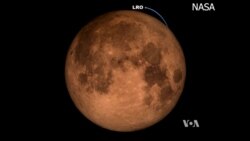In the wake of the pope’s visit to the United States, a rare – and unrelated celestial event – will happen in the heavens.
You’ll see it either Sunday or Monday, depending where you live.
What’s in store is a lunar eclipse, which by itself isn’t that uncommon. You might see as many as three of those a year. What’s special is that it coincides with a supermoon, when the moon is closer to Earth than any other time in its orbit. It appears bigger and brighter.
“The last supermoon and lunar eclipse was in 1982,” said Noah Petro, deputy project scientist for NASA's Lunar Reconnaissance Orbiter.
“So we’ll go from being very bright to turning this beautiful red color, the effect of the sunrises and sunsets of the Earth being projected on to the lunar surface,” he said.
September 2015 eclipse coincides with a supermoon when the moon appears larger and closer, as in this photo:
Taking moon's temperature
Petro said it’s a unique opportunity to measure the surface temperature of the moon.
“What we see is that surfaces that stay warm longer generally have larger blocks or smaller pebbles and things like that; where surfaces that cool off very quickly have smaller sand-sized particles; and so by measuring how the surface of the moon, the temperature of the surface of the moon changes during an eclipse, we learn about the makeup of the surface of the moon, the structure of the surface," he said.
NASA has had its eye on the moon for a long time, beginning with the Apollo program in the 1960's. In more recent years, the space agency has collected data from the Lunar Reconnaissance Orbiter [LRO] that flies as low as 20 kilometers above the moon's surface.
Petro said LRO discoveries have shown the moon is much more dynamic than previously thought.
“We are seeing new impact craters that have formed in the six years that we have been there. We are seeing evidence of migrating water across the surface. Not a lot of water, a small amount of water; but still the view that the moon is a static unchanging place is now completely different,” he said.
Natural lab for studying Earth's history
Some moon rocks date back 4.5 billion years to the earliest history of our solar system. Petro said that record is almost all gone from the Earth. He said studying the surface of the moon is a natural laboratory for investigation to see what was happening just after the planets formed.
“When we look at the moon, we are really looking into the deep history of the Earth as well,” he said. “I think from that we can learn a lot about how our planet has changed and how all planets have changed over time.”
The supermoon eclipse will be visible Sunday after sunset in North America and all of South America, and before dawn on Monday in Europe, the Middle East and Africa. While the event is rare, scientists can predict it; but your next opportunity to see this celestial wonder won't be until 2033.












